Second Year Report: Agriculture and Sustainable Development in Libya
VerifiedAdded on 2022/12/15
|42
|13996
|477
Report
AI Summary
This PhD economics report investigates agrarian change and sustainable development in Libya, examining the shift from an oil-dependent economy to sustainable agriculture. The study explores the historical context, including the pre-oil era and the subsequent decline in agriculture, analyzing the importance of agricultural development, economic diversification, and agricultural policies in both developing and oil-rich nations. The research aims to assess the sustainability of agriculture in Libya, addressing research objectives and questions related to the viability of agricultural practices. The report includes a literature review covering the significance of agriculture, agricultural development, and relevant economic indicators, alongside an analysis of the research methodology, significance, limitations, and potential contributions. The report highlights the critical role of agriculture in achieving food security and economic growth, particularly in light of Libya's reliance on oil revenues and the need for diversification to ensure long-term economic stability. The report also highlights the importance of modern technology and government policies to boost agricultural productivity and the challenges faced by the sector due to the armed crisis. The research also discusses the need for the country to diversify its economy and move away from reliance on oil production to secure its long-term economic growth.
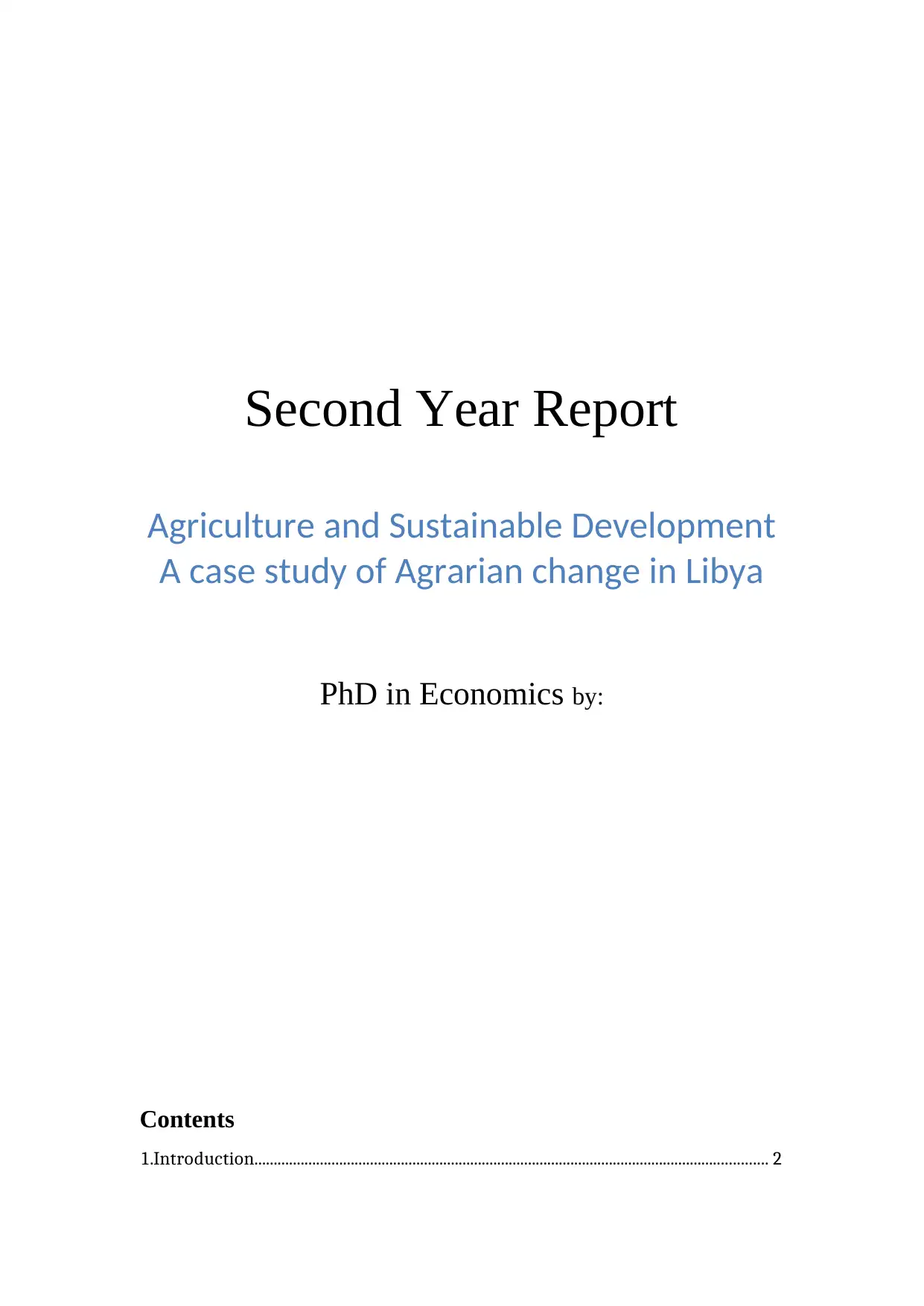
Second Year Report
Agriculture and Sustainable Development
A case study of Agrarian change in Libya
PhD in Economics by:
Contents
1.Introduction..................................................................................................................................... 2
Agriculture and Sustainable Development
A case study of Agrarian change in Libya
PhD in Economics by:
Contents
1.Introduction..................................................................................................................................... 2
Paraphrase This Document
Need a fresh take? Get an instant paraphrase of this document with our AI Paraphraser
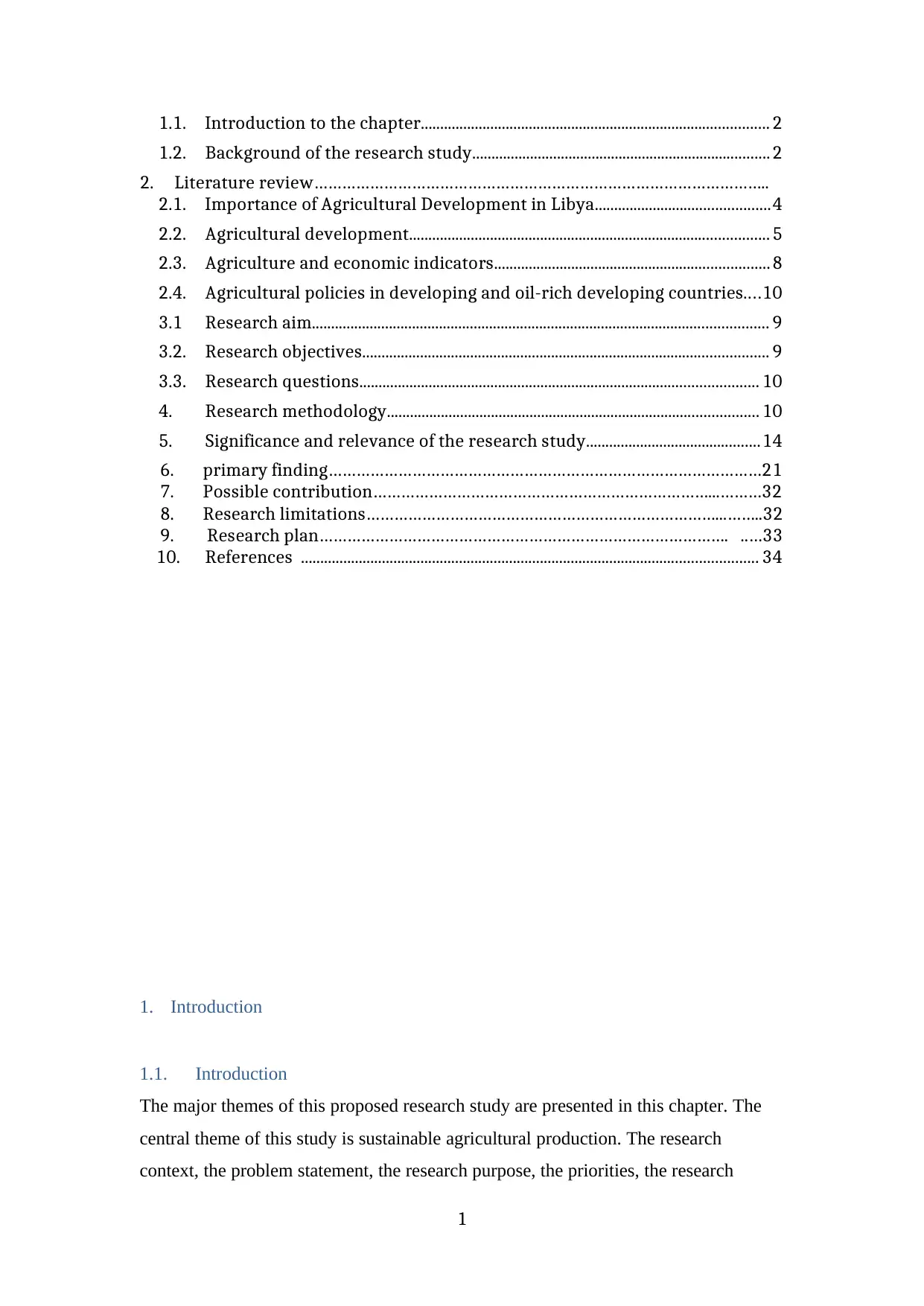
1.1. Introduction to the chapter.......................................................................................... 2
1.2. Background of the research study.............................................................................2
2. Literature review……………………………………………………………………………………..
2.1. Importance of Agricultural Development in Libya.............................................4
2.2. Agricultural development............................................................................................. 5
2.3. Agriculture and economic indicators.......................................................................8
2.4. Agricultural policies in developing and oil-rich developing countries....10
3.1 Research aim...................................................................................................................... 9
3.2. Research objectives......................................................................................................... 9
3.3. Research questions....................................................................................................... 10
4. Research methodology................................................................................................ 10
5. Significance and relevance of the research study.............................................14
6. primary finding…………………………………………………………………………………21
7. Possible contribution………………………………………………………………...………32
8. Research limitations…………………………………………………………………...……..32
9. Research plan……………………………………………………………………………. ..…33
10. References ...................................................................................................................... 34
1. Introduction
1.1. Introduction
The major themes of this proposed research study are presented in this chapter. The
central theme of this study is sustainable agricultural production. The research
context, the problem statement, the research purpose, the priorities, the research
1
1.2. Background of the research study.............................................................................2
2. Literature review……………………………………………………………………………………..
2.1. Importance of Agricultural Development in Libya.............................................4
2.2. Agricultural development............................................................................................. 5
2.3. Agriculture and economic indicators.......................................................................8
2.4. Agricultural policies in developing and oil-rich developing countries....10
3.1 Research aim...................................................................................................................... 9
3.2. Research objectives......................................................................................................... 9
3.3. Research questions....................................................................................................... 10
4. Research methodology................................................................................................ 10
5. Significance and relevance of the research study.............................................14
6. primary finding…………………………………………………………………………………21
7. Possible contribution………………………………………………………………...………32
8. Research limitations…………………………………………………………………...……..32
9. Research plan……………………………………………………………………………. ..…33
10. References ...................................................................................................................... 34
1. Introduction
1.1. Introduction
The major themes of this proposed research study are presented in this chapter. The
central theme of this study is sustainable agricultural production. The research
context, the problem statement, the research purpose, the priorities, the research
1
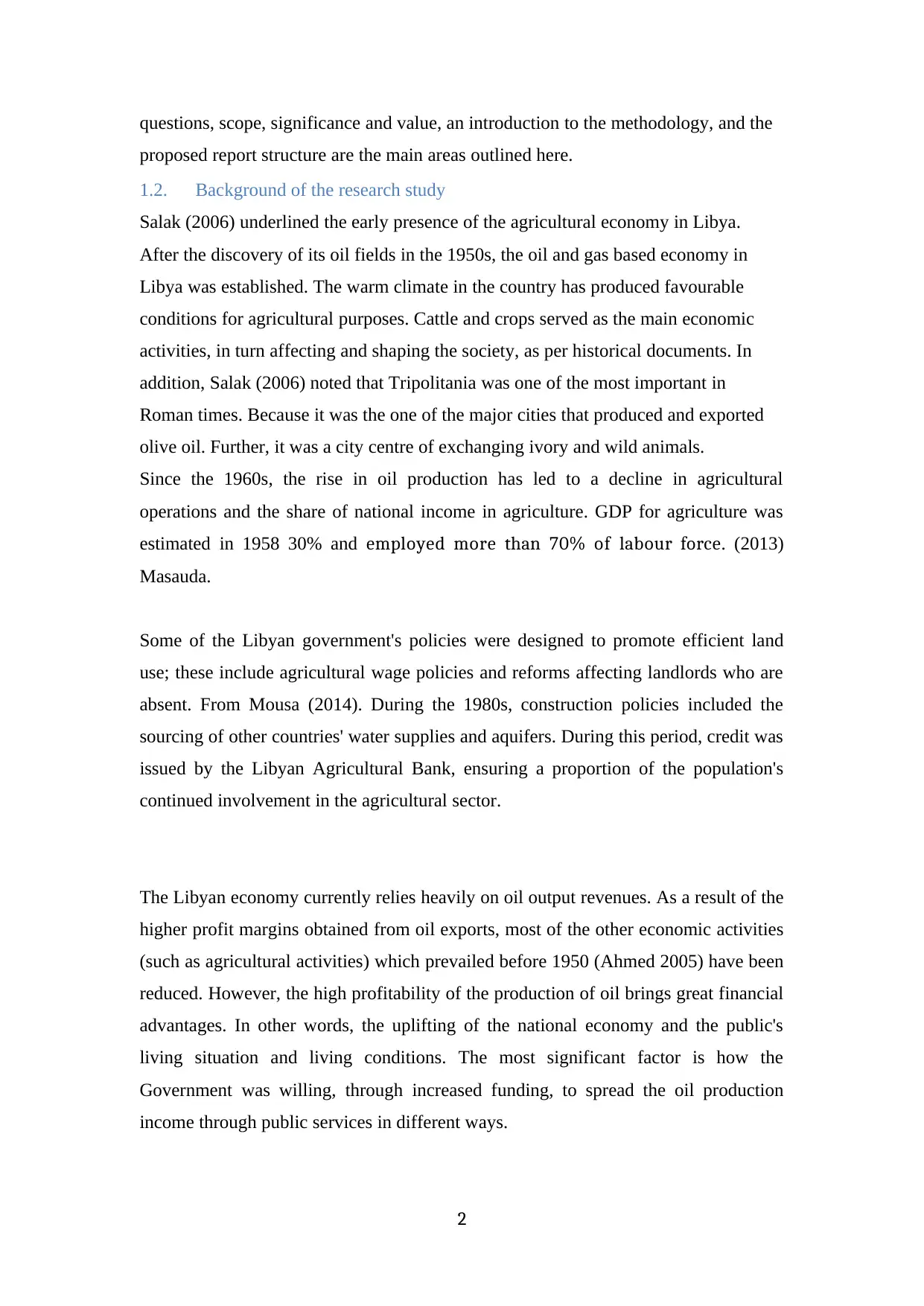
questions, scope, significance and value, an introduction to the methodology, and the
proposed report structure are the main areas outlined here.
1.2. Background of the research study
Salak (2006) underlined the early presence of the agricultural economy in Libya.
After the discovery of its oil fields in the 1950s, the oil and gas based economy in
Libya was established. The warm climate in the country has produced favourable
conditions for agricultural purposes. Cattle and crops served as the main economic
activities, in turn affecting and shaping the society, as per historical documents. In
addition, Salak (2006) noted that Tripolitania was one of the most important in
Roman times. Because it was the one of the major cities that produced and exported
olive oil. Further, it was a city centre of exchanging ivory and wild animals.
Since the 1960s, the rise in oil production has led to a decline in agricultural
operations and the share of national income in agriculture. GDP for agriculture was
estimated in 1958 30% and employed more than 70% of labour force. (2013)
Masauda.
Some of the Libyan government's policies were designed to promote efficient land
use; these include agricultural wage policies and reforms affecting landlords who are
absent. From Mousa (2014). During the 1980s, construction policies included the
sourcing of other countries' water supplies and aquifers. During this period, credit was
issued by the Libyan Agricultural Bank, ensuring a proportion of the population's
continued involvement in the agricultural sector.
The Libyan economy currently relies heavily on oil output revenues. As a result of the
higher profit margins obtained from oil exports, most of the other economic activities
(such as agricultural activities) which prevailed before 1950 (Ahmed 2005) have been
reduced. However, the high profitability of the production of oil brings great financial
advantages. In other words, the uplifting of the national economy and the public's
living situation and living conditions. The most significant factor is how the
Government was willing, through increased funding, to spread the oil production
income through public services in different ways.
2
proposed report structure are the main areas outlined here.
1.2. Background of the research study
Salak (2006) underlined the early presence of the agricultural economy in Libya.
After the discovery of its oil fields in the 1950s, the oil and gas based economy in
Libya was established. The warm climate in the country has produced favourable
conditions for agricultural purposes. Cattle and crops served as the main economic
activities, in turn affecting and shaping the society, as per historical documents. In
addition, Salak (2006) noted that Tripolitania was one of the most important in
Roman times. Because it was the one of the major cities that produced and exported
olive oil. Further, it was a city centre of exchanging ivory and wild animals.
Since the 1960s, the rise in oil production has led to a decline in agricultural
operations and the share of national income in agriculture. GDP for agriculture was
estimated in 1958 30% and employed more than 70% of labour force. (2013)
Masauda.
Some of the Libyan government's policies were designed to promote efficient land
use; these include agricultural wage policies and reforms affecting landlords who are
absent. From Mousa (2014). During the 1980s, construction policies included the
sourcing of other countries' water supplies and aquifers. During this period, credit was
issued by the Libyan Agricultural Bank, ensuring a proportion of the population's
continued involvement in the agricultural sector.
The Libyan economy currently relies heavily on oil output revenues. As a result of the
higher profit margins obtained from oil exports, most of the other economic activities
(such as agricultural activities) which prevailed before 1950 (Ahmed 2005) have been
reduced. However, the high profitability of the production of oil brings great financial
advantages. In other words, the uplifting of the national economy and the public's
living situation and living conditions. The most significant factor is how the
Government was willing, through increased funding, to spread the oil production
income through public services in different ways.
2
⊘ This is a preview!⊘
Do you want full access?
Subscribe today to unlock all pages.

Trusted by 1+ million students worldwide
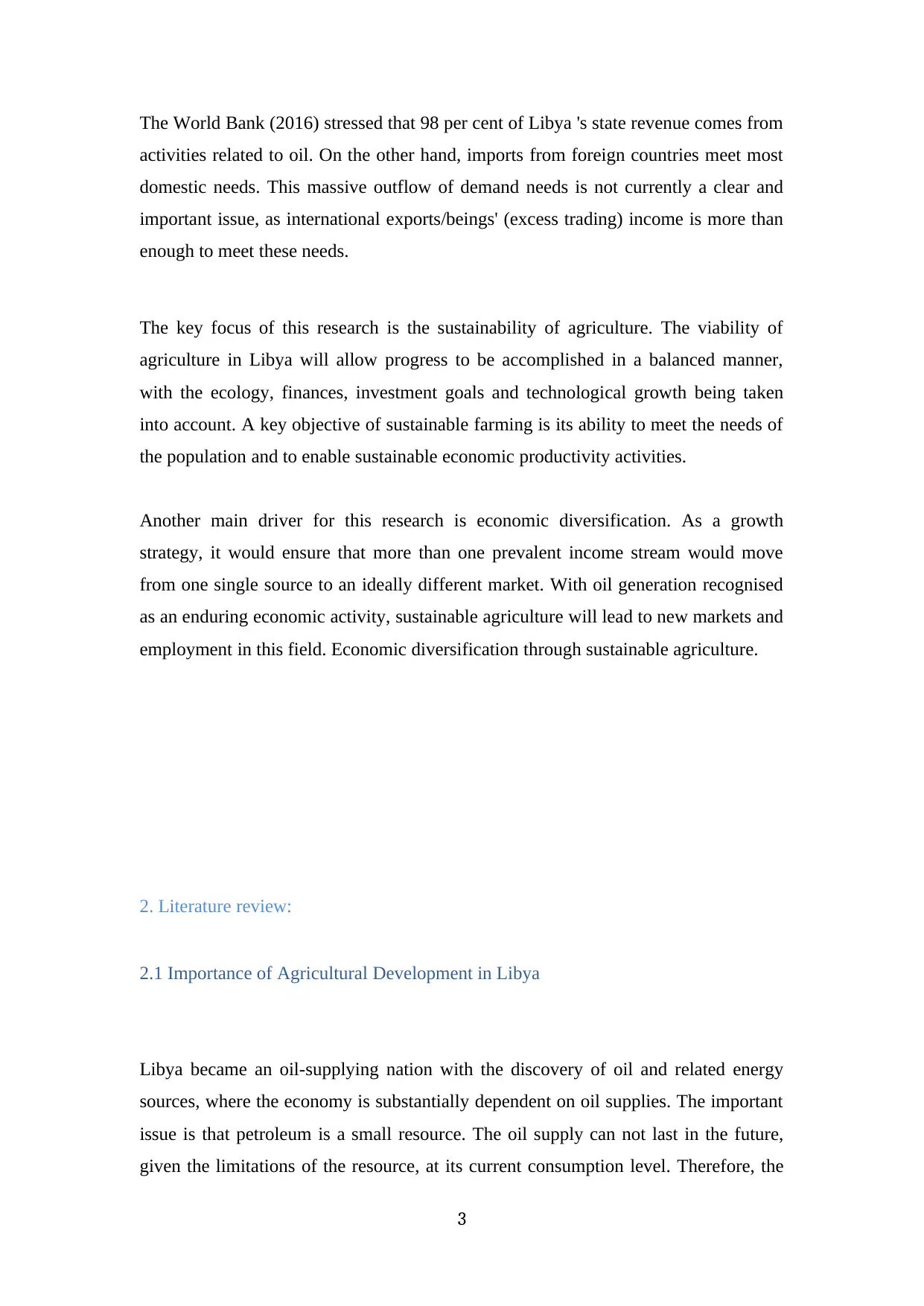
The World Bank (2016) stressed that 98 per cent of Libya 's state revenue comes from
activities related to oil. On the other hand, imports from foreign countries meet most
domestic needs. This massive outflow of demand needs is not currently a clear and
important issue, as international exports/beings' (excess trading) income is more than
enough to meet these needs.
The key focus of this research is the sustainability of agriculture. The viability of
agriculture in Libya will allow progress to be accomplished in a balanced manner,
with the ecology, finances, investment goals and technological growth being taken
into account. A key objective of sustainable farming is its ability to meet the needs of
the population and to enable sustainable economic productivity activities.
Another main driver for this research is economic diversification. As a growth
strategy, it would ensure that more than one prevalent income stream would move
from one single source to an ideally different market. With oil generation recognised
as an enduring economic activity, sustainable agriculture will lead to new markets and
employment in this field. Economic diversification through sustainable agriculture.
2. Literature review:
2.1 Importance of Agricultural Development in Libya
Libya became an oil-supplying nation with the discovery of oil and related energy
sources, where the economy is substantially dependent on oil supplies. The important
issue is that petroleum is a small resource. The oil supply can not last in the future,
given the limitations of the resource, at its current consumption level. Therefore, the
3
activities related to oil. On the other hand, imports from foreign countries meet most
domestic needs. This massive outflow of demand needs is not currently a clear and
important issue, as international exports/beings' (excess trading) income is more than
enough to meet these needs.
The key focus of this research is the sustainability of agriculture. The viability of
agriculture in Libya will allow progress to be accomplished in a balanced manner,
with the ecology, finances, investment goals and technological growth being taken
into account. A key objective of sustainable farming is its ability to meet the needs of
the population and to enable sustainable economic productivity activities.
Another main driver for this research is economic diversification. As a growth
strategy, it would ensure that more than one prevalent income stream would move
from one single source to an ideally different market. With oil generation recognised
as an enduring economic activity, sustainable agriculture will lead to new markets and
employment in this field. Economic diversification through sustainable agriculture.
2. Literature review:
2.1 Importance of Agricultural Development in Libya
Libya became an oil-supplying nation with the discovery of oil and related energy
sources, where the economy is substantially dependent on oil supplies. The important
issue is that petroleum is a small resource. The oil supply can not last in the future,
given the limitations of the resource, at its current consumption level. Therefore, the
3
Paraphrase This Document
Need a fresh take? Get an instant paraphrase of this document with our AI Paraphraser
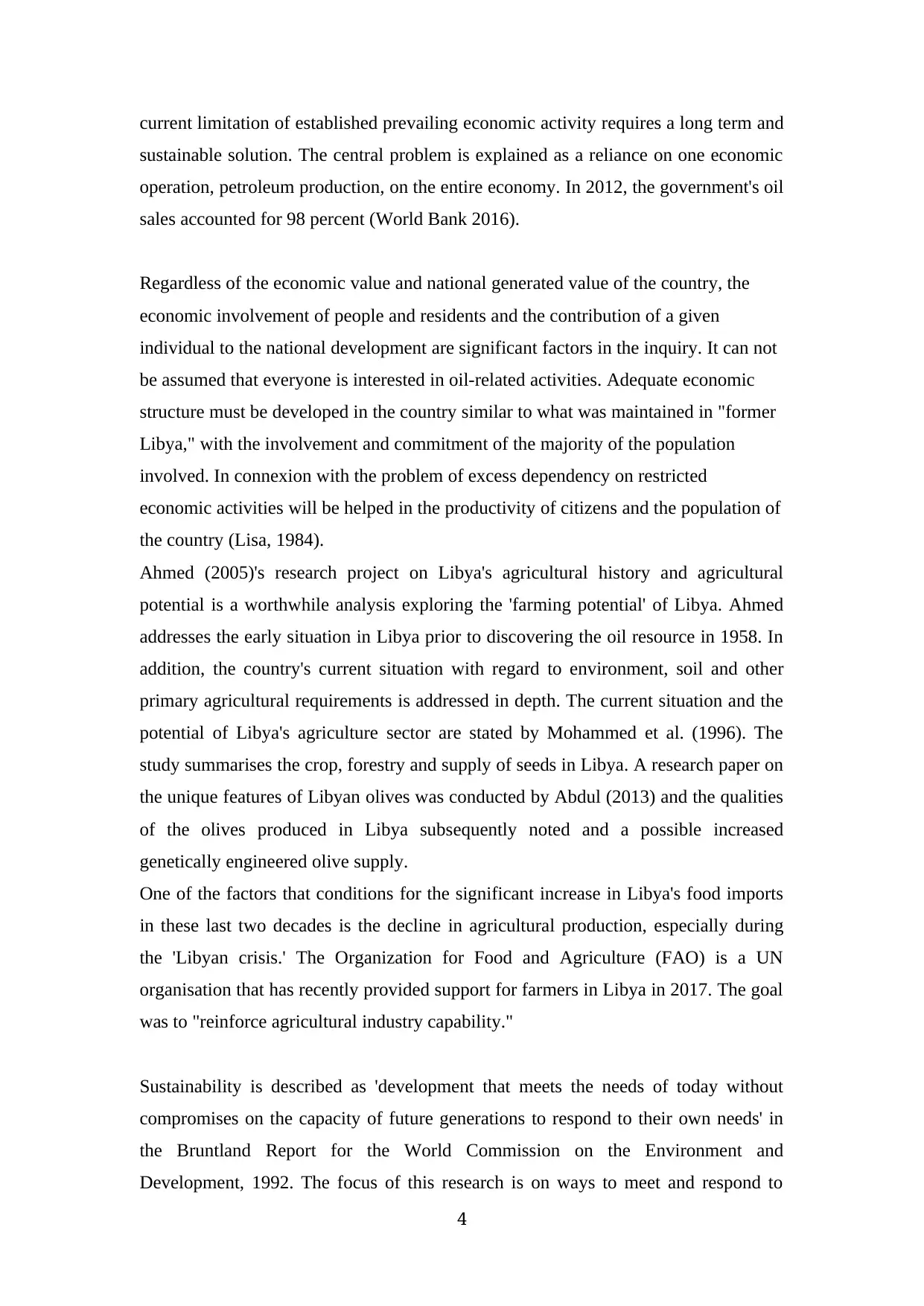
current limitation of established prevailing economic activity requires a long term and
sustainable solution. The central problem is explained as a reliance on one economic
operation, petroleum production, on the entire economy. In 2012, the government's oil
sales accounted for 98 percent (World Bank 2016).
Regardless of the economic value and national generated value of the country, the
economic involvement of people and residents and the contribution of a given
individual to the national development are significant factors in the inquiry. It can not
be assumed that everyone is interested in oil-related activities. Adequate economic
structure must be developed in the country similar to what was maintained in "former
Libya," with the involvement and commitment of the majority of the population
involved. In connexion with the problem of excess dependency on restricted
economic activities will be helped in the productivity of citizens and the population of
the country (Lisa, 1984).
Ahmed (2005)'s research project on Libya's agricultural history and agricultural
potential is a worthwhile analysis exploring the 'farming potential' of Libya. Ahmed
addresses the early situation in Libya prior to discovering the oil resource in 1958. In
addition, the country's current situation with regard to environment, soil and other
primary agricultural requirements is addressed in depth. The current situation and the
potential of Libya's agriculture sector are stated by Mohammed et al. (1996). The
study summarises the crop, forestry and supply of seeds in Libya. A research paper on
the unique features of Libyan olives was conducted by Abdul (2013) and the qualities
of the olives produced in Libya subsequently noted and a possible increased
genetically engineered olive supply.
One of the factors that conditions for the significant increase in Libya's food imports
in these last two decades is the decline in agricultural production, especially during
the 'Libyan crisis.' The Organization for Food and Agriculture (FAO) is a UN
organisation that has recently provided support for farmers in Libya in 2017. The goal
was to "reinforce agricultural industry capability."
Sustainability is described as 'development that meets the needs of today without
compromises on the capacity of future generations to respond to their own needs' in
the Bruntland Report for the World Commission on the Environment and
Development, 1992. The focus of this research is on ways to meet and respond to
4
sustainable solution. The central problem is explained as a reliance on one economic
operation, petroleum production, on the entire economy. In 2012, the government's oil
sales accounted for 98 percent (World Bank 2016).
Regardless of the economic value and national generated value of the country, the
economic involvement of people and residents and the contribution of a given
individual to the national development are significant factors in the inquiry. It can not
be assumed that everyone is interested in oil-related activities. Adequate economic
structure must be developed in the country similar to what was maintained in "former
Libya," with the involvement and commitment of the majority of the population
involved. In connexion with the problem of excess dependency on restricted
economic activities will be helped in the productivity of citizens and the population of
the country (Lisa, 1984).
Ahmed (2005)'s research project on Libya's agricultural history and agricultural
potential is a worthwhile analysis exploring the 'farming potential' of Libya. Ahmed
addresses the early situation in Libya prior to discovering the oil resource in 1958. In
addition, the country's current situation with regard to environment, soil and other
primary agricultural requirements is addressed in depth. The current situation and the
potential of Libya's agriculture sector are stated by Mohammed et al. (1996). The
study summarises the crop, forestry and supply of seeds in Libya. A research paper on
the unique features of Libyan olives was conducted by Abdul (2013) and the qualities
of the olives produced in Libya subsequently noted and a possible increased
genetically engineered olive supply.
One of the factors that conditions for the significant increase in Libya's food imports
in these last two decades is the decline in agricultural production, especially during
the 'Libyan crisis.' The Organization for Food and Agriculture (FAO) is a UN
organisation that has recently provided support for farmers in Libya in 2017. The goal
was to "reinforce agricultural industry capability."
Sustainability is described as 'development that meets the needs of today without
compromises on the capacity of future generations to respond to their own needs' in
the Bruntland Report for the World Commission on the Environment and
Development, 1992. The focus of this research is on ways to meet and respond to
4
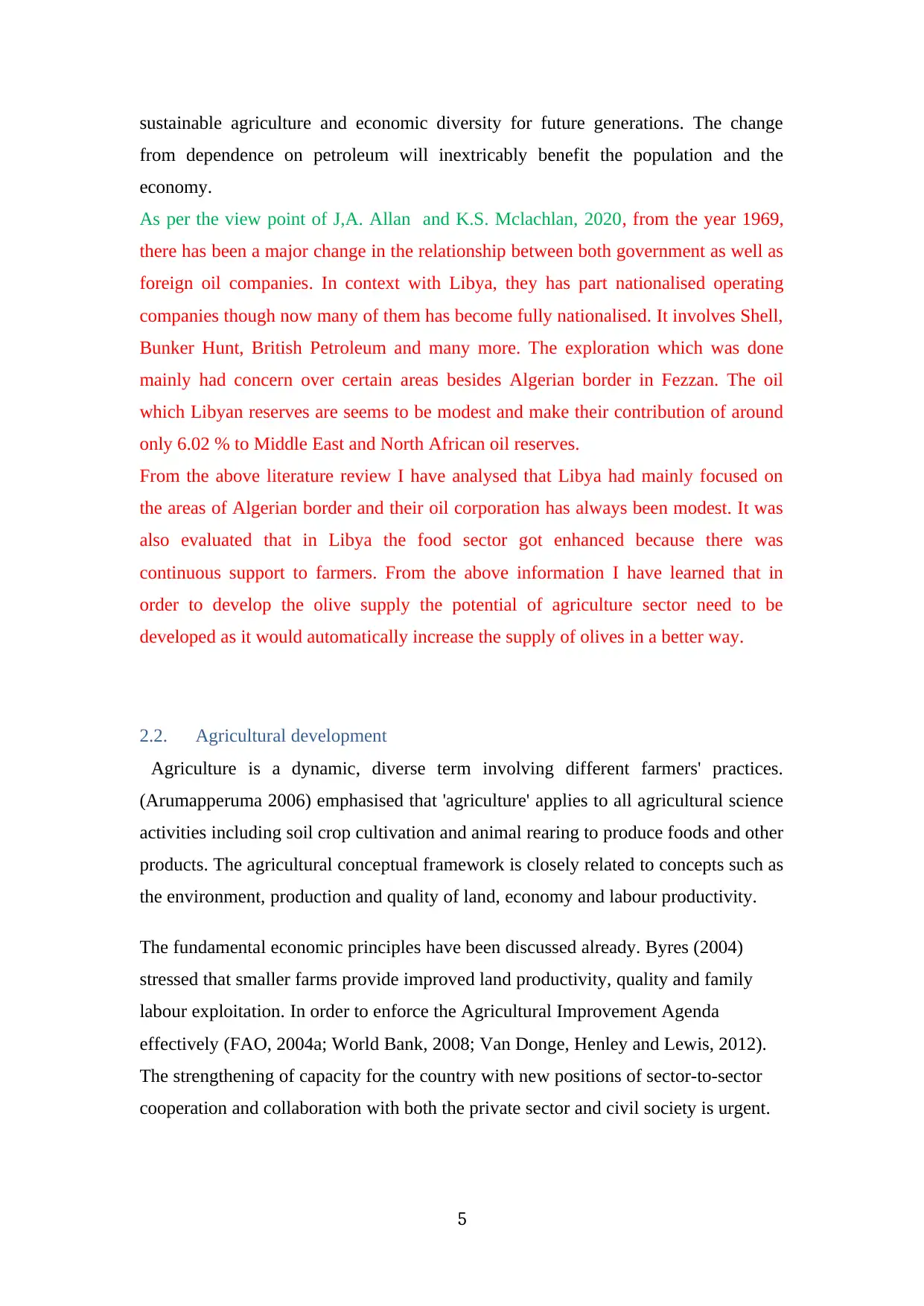
sustainable agriculture and economic diversity for future generations. The change
from dependence on petroleum will inextricably benefit the population and the
economy.
As per the view point of J,A. Allan and K.S. Mclachlan, 2020, from the year 1969,
there has been a major change in the relationship between both government as well as
foreign oil companies. In context with Libya, they has part nationalised operating
companies though now many of them has become fully nationalised. It involves Shell,
Bunker Hunt, British Petroleum and many more. The exploration which was done
mainly had concern over certain areas besides Algerian border in Fezzan. The oil
which Libyan reserves are seems to be modest and make their contribution of around
only 6.02 % to Middle East and North African oil reserves.
From the above literature review I have analysed that Libya had mainly focused on
the areas of Algerian border and their oil corporation has always been modest. It was
also evaluated that in Libya the food sector got enhanced because there was
continuous support to farmers. From the above information I have learned that in
order to develop the olive supply the potential of agriculture sector need to be
developed as it would automatically increase the supply of olives in a better way.
2.2. Agricultural development
Agriculture is a dynamic, diverse term involving different farmers' practices.
(Arumapperuma 2006) emphasised that 'agriculture' applies to all agricultural science
activities including soil crop cultivation and animal rearing to produce foods and other
products. The agricultural conceptual framework is closely related to concepts such as
the environment, production and quality of land, economy and labour productivity.
The fundamental economic principles have been discussed already. Byres (2004)
stressed that smaller farms provide improved land productivity, quality and family
labour exploitation. In order to enforce the Agricultural Improvement Agenda
effectively (FAO, 2004a; World Bank, 2008; Van Donge, Henley and Lewis, 2012).
The strengthening of capacity for the country with new positions of sector-to-sector
cooperation and collaboration with both the private sector and civil society is urgent.
5
from dependence on petroleum will inextricably benefit the population and the
economy.
As per the view point of J,A. Allan and K.S. Mclachlan, 2020, from the year 1969,
there has been a major change in the relationship between both government as well as
foreign oil companies. In context with Libya, they has part nationalised operating
companies though now many of them has become fully nationalised. It involves Shell,
Bunker Hunt, British Petroleum and many more. The exploration which was done
mainly had concern over certain areas besides Algerian border in Fezzan. The oil
which Libyan reserves are seems to be modest and make their contribution of around
only 6.02 % to Middle East and North African oil reserves.
From the above literature review I have analysed that Libya had mainly focused on
the areas of Algerian border and their oil corporation has always been modest. It was
also evaluated that in Libya the food sector got enhanced because there was
continuous support to farmers. From the above information I have learned that in
order to develop the olive supply the potential of agriculture sector need to be
developed as it would automatically increase the supply of olives in a better way.
2.2. Agricultural development
Agriculture is a dynamic, diverse term involving different farmers' practices.
(Arumapperuma 2006) emphasised that 'agriculture' applies to all agricultural science
activities including soil crop cultivation and animal rearing to produce foods and other
products. The agricultural conceptual framework is closely related to concepts such as
the environment, production and quality of land, economy and labour productivity.
The fundamental economic principles have been discussed already. Byres (2004)
stressed that smaller farms provide improved land productivity, quality and family
labour exploitation. In order to enforce the Agricultural Improvement Agenda
effectively (FAO, 2004a; World Bank, 2008; Van Donge, Henley and Lewis, 2012).
The strengthening of capacity for the country with new positions of sector-to-sector
cooperation and collaboration with both the private sector and civil society is urgent.
5
⊘ This is a preview!⊘
Do you want full access?
Subscribe today to unlock all pages.

Trusted by 1+ million students worldwide
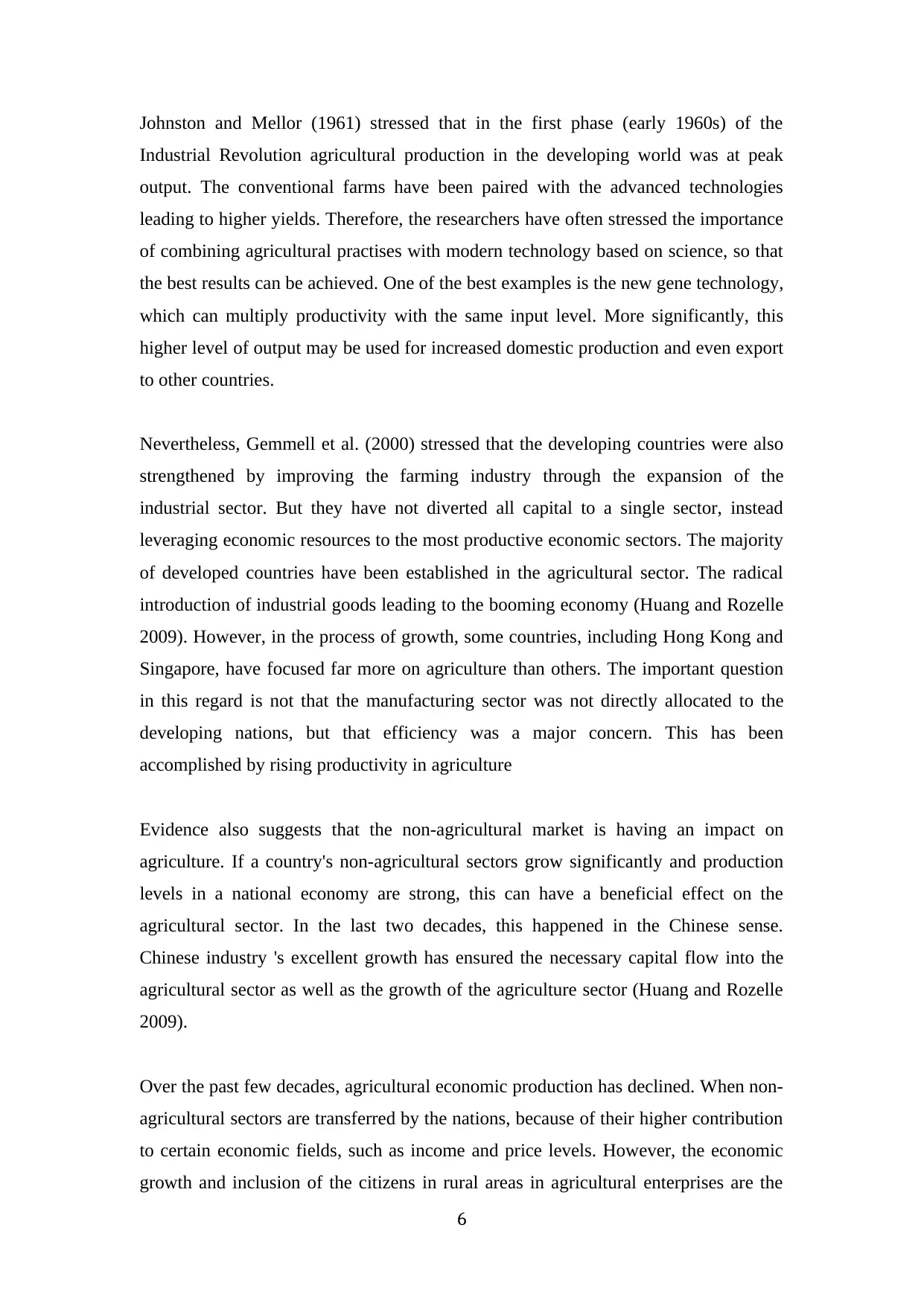
Johnston and Mellor (1961) stressed that in the first phase (early 1960s) of the
Industrial Revolution agricultural production in the developing world was at peak
output. The conventional farms have been paired with the advanced technologies
leading to higher yields. Therefore, the researchers have often stressed the importance
of combining agricultural practises with modern technology based on science, so that
the best results can be achieved. One of the best examples is the new gene technology,
which can multiply productivity with the same input level. More significantly, this
higher level of output may be used for increased domestic production and even export
to other countries.
Nevertheless, Gemmell et al. (2000) stressed that the developing countries were also
strengthened by improving the farming industry through the expansion of the
industrial sector. But they have not diverted all capital to a single sector, instead
leveraging economic resources to the most productive economic sectors. The majority
of developed countries have been established in the agricultural sector. The radical
introduction of industrial goods leading to the booming economy (Huang and Rozelle
2009). However, in the process of growth, some countries, including Hong Kong and
Singapore, have focused far more on agriculture than others. The important question
in this regard is not that the manufacturing sector was not directly allocated to the
developing nations, but that efficiency was a major concern. This has been
accomplished by rising productivity in agriculture
Evidence also suggests that the non-agricultural market is having an impact on
agriculture. If a country's non-agricultural sectors grow significantly and production
levels in a national economy are strong, this can have a beneficial effect on the
agricultural sector. In the last two decades, this happened in the Chinese sense.
Chinese industry 's excellent growth has ensured the necessary capital flow into the
agricultural sector as well as the growth of the agriculture sector (Huang and Rozelle
2009).
Over the past few decades, agricultural economic production has declined. When non-
agricultural sectors are transferred by the nations, because of their higher contribution
to certain economic fields, such as income and price levels. However, the economic
growth and inclusion of the citizens in rural areas in agricultural enterprises are the
6
Industrial Revolution agricultural production in the developing world was at peak
output. The conventional farms have been paired with the advanced technologies
leading to higher yields. Therefore, the researchers have often stressed the importance
of combining agricultural practises with modern technology based on science, so that
the best results can be achieved. One of the best examples is the new gene technology,
which can multiply productivity with the same input level. More significantly, this
higher level of output may be used for increased domestic production and even export
to other countries.
Nevertheless, Gemmell et al. (2000) stressed that the developing countries were also
strengthened by improving the farming industry through the expansion of the
industrial sector. But they have not diverted all capital to a single sector, instead
leveraging economic resources to the most productive economic sectors. The majority
of developed countries have been established in the agricultural sector. The radical
introduction of industrial goods leading to the booming economy (Huang and Rozelle
2009). However, in the process of growth, some countries, including Hong Kong and
Singapore, have focused far more on agriculture than others. The important question
in this regard is not that the manufacturing sector was not directly allocated to the
developing nations, but that efficiency was a major concern. This has been
accomplished by rising productivity in agriculture
Evidence also suggests that the non-agricultural market is having an impact on
agriculture. If a country's non-agricultural sectors grow significantly and production
levels in a national economy are strong, this can have a beneficial effect on the
agricultural sector. In the last two decades, this happened in the Chinese sense.
Chinese industry 's excellent growth has ensured the necessary capital flow into the
agricultural sector as well as the growth of the agriculture sector (Huang and Rozelle
2009).
Over the past few decades, agricultural economic production has declined. When non-
agricultural sectors are transferred by the nations, because of their higher contribution
to certain economic fields, such as income and price levels. However, the economic
growth and inclusion of the citizens in rural areas in agricultural enterprises are the
6
Paraphrase This Document
Need a fresh take? Get an instant paraphrase of this document with our AI Paraphraser

concern of the local governments in developing countries. Economic growth and
poverty reduction are the key goals of this process.
As per the view point of Qamar, 2013, the agriculture sector is considered as the most
crucial economic department in Libya until the oil got discovered. When oil got
implemented it became the major driving force for overall economy of country while
developing the agriculture sector that ultimately result into certain food imports. The
focus is mainly on the aspect of agriculture through enhanced threats of food
insecurity. The labourers who use to live in Libya sine long period of time also left the
country because of armed crisis that created an impact on agriculture production.
As per the view point of Alazragh. 2020, the conditions of achieving food security
and agriculture have reached to the critical stage as it represent in the growing
demand for all agricultural products in relation with general as well as food items due
to which it had led to high rates of demographic growth through which the food prices
got rise in global markets and decreased importance of the agricultural sector in
context with the Libyan economic structure. There are certain aspects of Libyan food
security crisis like it analyses the causes of overall crisis due to the inability of Libyan
agricultural policies to fulfil food security. It was been determined that the situation
led to low rate of self-sufficiency for crops because of inability of agricultural policies
to achieve food security mainly the policies in order to support overall agricultural
sector in Libya.
2.3. Agriculture and economic indicators
The agricultural development and the economic development of a country are closely
associated in the developing country context. In most developing countries, the major
sector in the economy is the agricultural sector. Therefore, an overall increase in the
contribution of the sector to the economy could directly result in growth in the
economy. Furthermore, agriculture is a sector that can exist all throughout a particular
country. Resultingly, it can be expected that the benefits extend to and are accessible
to people in rural areas also. In the agricultural sector, the most prominent aspects are
labour productivity and land productivity (Ravallion and Datt, 1996). Thus, it is
significant that these two aspects are across a country instead of concentrated
accumulated in a particular area. Also, this distribution of the sector is based on the
geography and the placement of the natural resources.
7
poverty reduction are the key goals of this process.
As per the view point of Qamar, 2013, the agriculture sector is considered as the most
crucial economic department in Libya until the oil got discovered. When oil got
implemented it became the major driving force for overall economy of country while
developing the agriculture sector that ultimately result into certain food imports. The
focus is mainly on the aspect of agriculture through enhanced threats of food
insecurity. The labourers who use to live in Libya sine long period of time also left the
country because of armed crisis that created an impact on agriculture production.
As per the view point of Alazragh. 2020, the conditions of achieving food security
and agriculture have reached to the critical stage as it represent in the growing
demand for all agricultural products in relation with general as well as food items due
to which it had led to high rates of demographic growth through which the food prices
got rise in global markets and decreased importance of the agricultural sector in
context with the Libyan economic structure. There are certain aspects of Libyan food
security crisis like it analyses the causes of overall crisis due to the inability of Libyan
agricultural policies to fulfil food security. It was been determined that the situation
led to low rate of self-sufficiency for crops because of inability of agricultural policies
to achieve food security mainly the policies in order to support overall agricultural
sector in Libya.
2.3. Agriculture and economic indicators
The agricultural development and the economic development of a country are closely
associated in the developing country context. In most developing countries, the major
sector in the economy is the agricultural sector. Therefore, an overall increase in the
contribution of the sector to the economy could directly result in growth in the
economy. Furthermore, agriculture is a sector that can exist all throughout a particular
country. Resultingly, it can be expected that the benefits extend to and are accessible
to people in rural areas also. In the agricultural sector, the most prominent aspects are
labour productivity and land productivity (Ravallion and Datt, 1996). Thus, it is
significant that these two aspects are across a country instead of concentrated
accumulated in a particular area. Also, this distribution of the sector is based on the
geography and the placement of the natural resources.
7
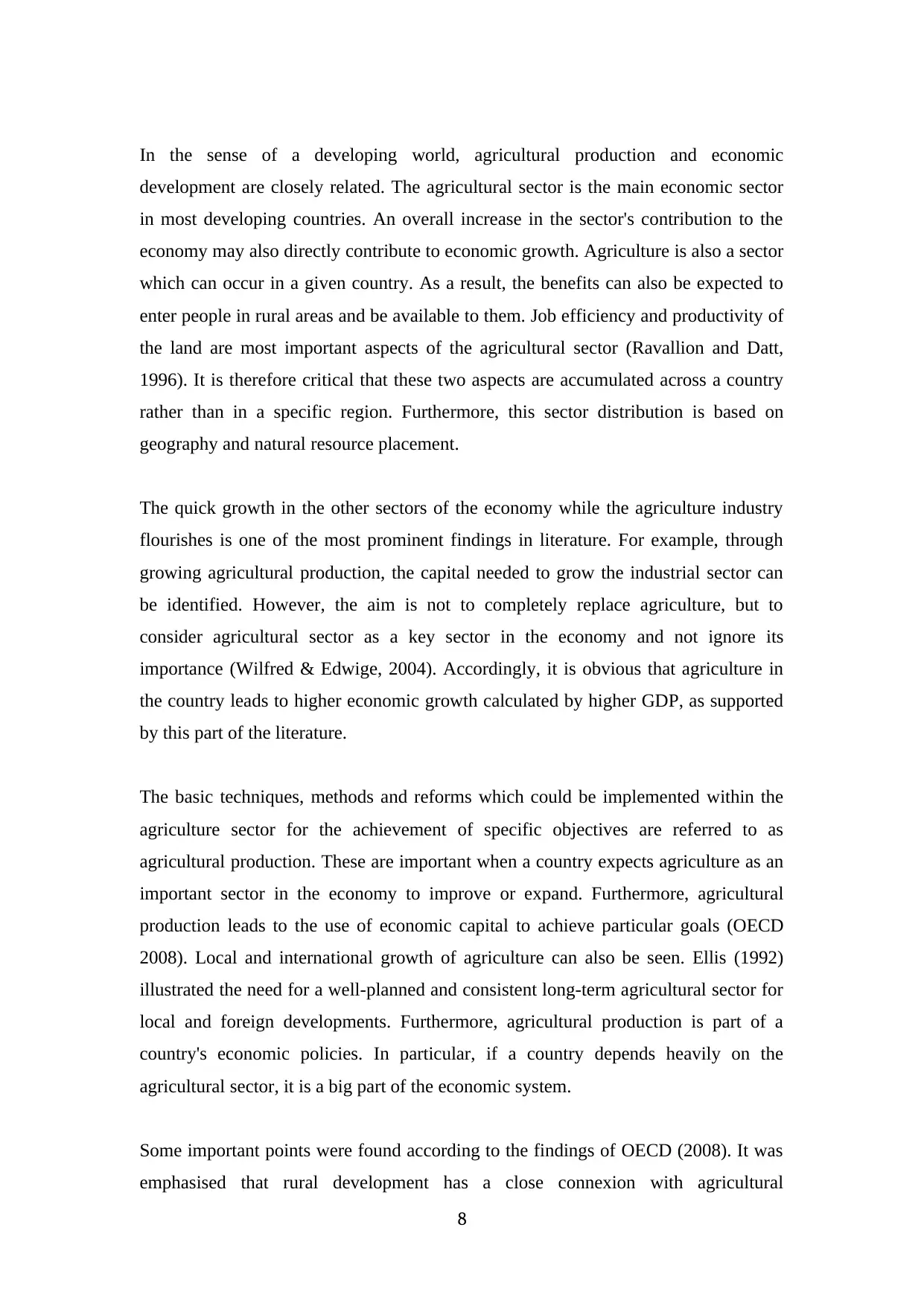
In the sense of a developing world, agricultural production and economic
development are closely related. The agricultural sector is the main economic sector
in most developing countries. An overall increase in the sector's contribution to the
economy may also directly contribute to economic growth. Agriculture is also a sector
which can occur in a given country. As a result, the benefits can also be expected to
enter people in rural areas and be available to them. Job efficiency and productivity of
the land are most important aspects of the agricultural sector (Ravallion and Datt,
1996). It is therefore critical that these two aspects are accumulated across a country
rather than in a specific region. Furthermore, this sector distribution is based on
geography and natural resource placement.
The quick growth in the other sectors of the economy while the agriculture industry
flourishes is one of the most prominent findings in literature. For example, through
growing agricultural production, the capital needed to grow the industrial sector can
be identified. However, the aim is not to completely replace agriculture, but to
consider agricultural sector as a key sector in the economy and not ignore its
importance (Wilfred & Edwige, 2004). Accordingly, it is obvious that agriculture in
the country leads to higher economic growth calculated by higher GDP, as supported
by this part of the literature.
The basic techniques, methods and reforms which could be implemented within the
agriculture sector for the achievement of specific objectives are referred to as
agricultural production. These are important when a country expects agriculture as an
important sector in the economy to improve or expand. Furthermore, agricultural
production leads to the use of economic capital to achieve particular goals (OECD
2008). Local and international growth of agriculture can also be seen. Ellis (1992)
illustrated the need for a well-planned and consistent long-term agricultural sector for
local and foreign developments. Furthermore, agricultural production is part of a
country's economic policies. In particular, if a country depends heavily on the
agricultural sector, it is a big part of the economic system.
Some important points were found according to the findings of OECD (2008). It was
emphasised that rural development has a close connexion with agricultural
8
development are closely related. The agricultural sector is the main economic sector
in most developing countries. An overall increase in the sector's contribution to the
economy may also directly contribute to economic growth. Agriculture is also a sector
which can occur in a given country. As a result, the benefits can also be expected to
enter people in rural areas and be available to them. Job efficiency and productivity of
the land are most important aspects of the agricultural sector (Ravallion and Datt,
1996). It is therefore critical that these two aspects are accumulated across a country
rather than in a specific region. Furthermore, this sector distribution is based on
geography and natural resource placement.
The quick growth in the other sectors of the economy while the agriculture industry
flourishes is one of the most prominent findings in literature. For example, through
growing agricultural production, the capital needed to grow the industrial sector can
be identified. However, the aim is not to completely replace agriculture, but to
consider agricultural sector as a key sector in the economy and not ignore its
importance (Wilfred & Edwige, 2004). Accordingly, it is obvious that agriculture in
the country leads to higher economic growth calculated by higher GDP, as supported
by this part of the literature.
The basic techniques, methods and reforms which could be implemented within the
agriculture sector for the achievement of specific objectives are referred to as
agricultural production. These are important when a country expects agriculture as an
important sector in the economy to improve or expand. Furthermore, agricultural
production leads to the use of economic capital to achieve particular goals (OECD
2008). Local and international growth of agriculture can also be seen. Ellis (1992)
illustrated the need for a well-planned and consistent long-term agricultural sector for
local and foreign developments. Furthermore, agricultural production is part of a
country's economic policies. In particular, if a country depends heavily on the
agricultural sector, it is a big part of the economic system.
Some important points were found according to the findings of OECD (2008). It was
emphasised that rural development has a close connexion with agricultural
8
⊘ This is a preview!⊘
Do you want full access?
Subscribe today to unlock all pages.

Trusted by 1+ million students worldwide
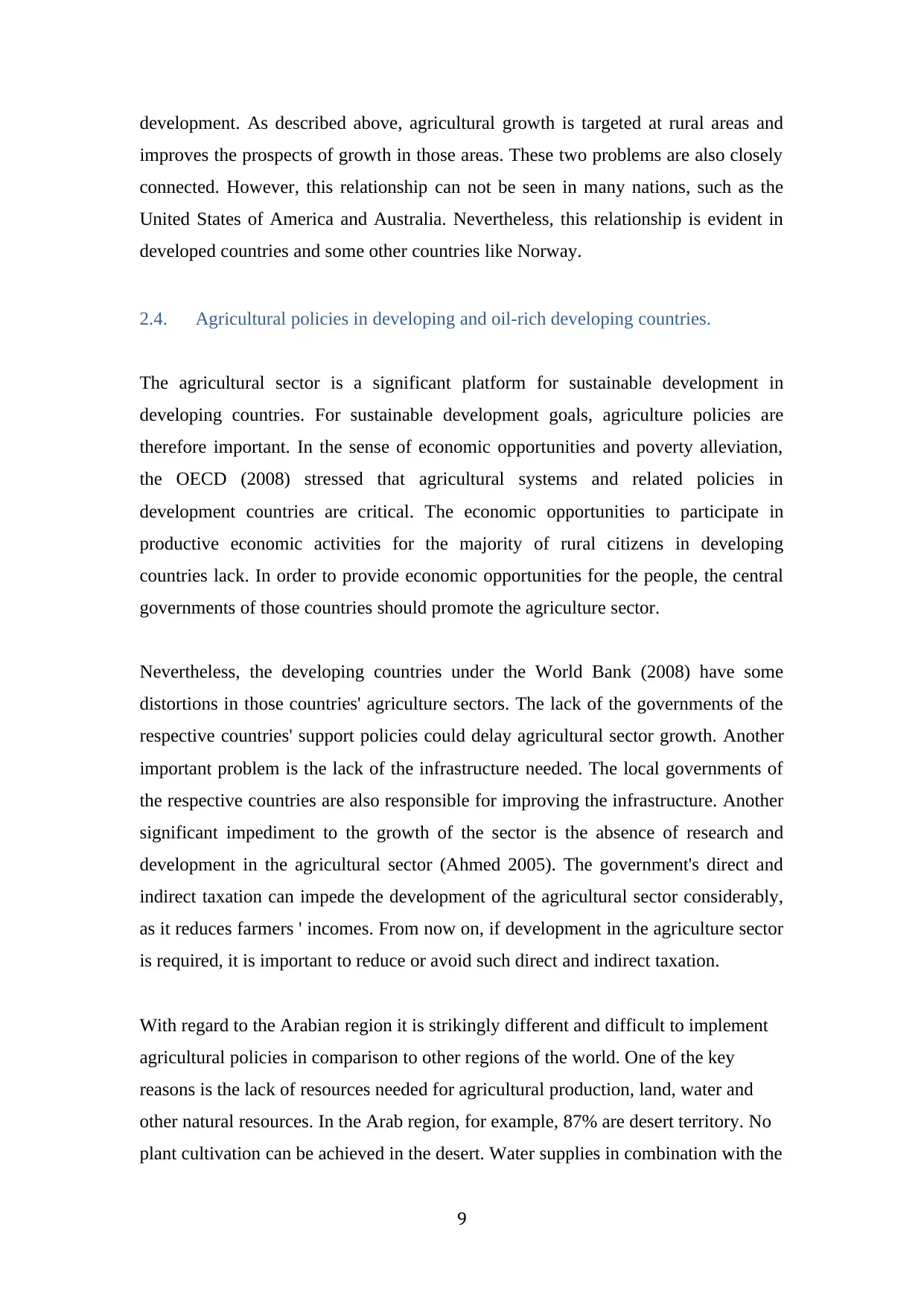
development. As described above, agricultural growth is targeted at rural areas and
improves the prospects of growth in those areas. These two problems are also closely
connected. However, this relationship can not be seen in many nations, such as the
United States of America and Australia. Nevertheless, this relationship is evident in
developed countries and some other countries like Norway.
2.4. Agricultural policies in developing and oil-rich developing countries.
The agricultural sector is a significant platform for sustainable development in
developing countries. For sustainable development goals, agriculture policies are
therefore important. In the sense of economic opportunities and poverty alleviation,
the OECD (2008) stressed that agricultural systems and related policies in
development countries are critical. The economic opportunities to participate in
productive economic activities for the majority of rural citizens in developing
countries lack. In order to provide economic opportunities for the people, the central
governments of those countries should promote the agriculture sector.
Nevertheless, the developing countries under the World Bank (2008) have some
distortions in those countries' agriculture sectors. The lack of the governments of the
respective countries' support policies could delay agricultural sector growth. Another
important problem is the lack of the infrastructure needed. The local governments of
the respective countries are also responsible for improving the infrastructure. Another
significant impediment to the growth of the sector is the absence of research and
development in the agricultural sector (Ahmed 2005). The government's direct and
indirect taxation can impede the development of the agricultural sector considerably,
as it reduces farmers ' incomes. From now on, if development in the agriculture sector
is required, it is important to reduce or avoid such direct and indirect taxation.
With regard to the Arabian region it is strikingly different and difficult to implement
agricultural policies in comparison to other regions of the world. One of the key
reasons is the lack of resources needed for agricultural production, land, water and
other natural resources. In the Arab region, for example, 87% are desert territory. No
plant cultivation can be achieved in the desert. Water supplies in combination with the
9
improves the prospects of growth in those areas. These two problems are also closely
connected. However, this relationship can not be seen in many nations, such as the
United States of America and Australia. Nevertheless, this relationship is evident in
developed countries and some other countries like Norway.
2.4. Agricultural policies in developing and oil-rich developing countries.
The agricultural sector is a significant platform for sustainable development in
developing countries. For sustainable development goals, agriculture policies are
therefore important. In the sense of economic opportunities and poverty alleviation,
the OECD (2008) stressed that agricultural systems and related policies in
development countries are critical. The economic opportunities to participate in
productive economic activities for the majority of rural citizens in developing
countries lack. In order to provide economic opportunities for the people, the central
governments of those countries should promote the agriculture sector.
Nevertheless, the developing countries under the World Bank (2008) have some
distortions in those countries' agriculture sectors. The lack of the governments of the
respective countries' support policies could delay agricultural sector growth. Another
important problem is the lack of the infrastructure needed. The local governments of
the respective countries are also responsible for improving the infrastructure. Another
significant impediment to the growth of the sector is the absence of research and
development in the agricultural sector (Ahmed 2005). The government's direct and
indirect taxation can impede the development of the agricultural sector considerably,
as it reduces farmers ' incomes. From now on, if development in the agriculture sector
is required, it is important to reduce or avoid such direct and indirect taxation.
With regard to the Arabian region it is strikingly different and difficult to implement
agricultural policies in comparison to other regions of the world. One of the key
reasons is the lack of resources needed for agricultural production, land, water and
other natural resources. In the Arab region, for example, 87% are desert territory. No
plant cultivation can be achieved in the desert. Water supplies in combination with the
9
Paraphrase This Document
Need a fresh take? Get an instant paraphrase of this document with our AI Paraphraser

desert are also rare. The urban population in Libya is less than 40 percent, which
suggests that there is a higher rural population. Agricultural activities still use 87% of
the available water (UNDP 2007).
.
3.1. Research aim
The aim of the research study is to critically evaluate the drawbacks of the existing
economic system in Libya, and propose a more sustainable and productive structure
based on agricultural activities, as existed in the country before the oil resource was
found.
3.2. Key objectives
To recognize the prevailing economic policies and structure in Libya
To critically review and evaluate pre- and post-Gaddafi policies in the
agricultural sector.
To critically analyses and evaluate how the problems affecting the Libyan
agricultural sector impact the potential for other economic activities in the
modernization of this sector
To critically evaluate how problems affecting the Libyan agricultural sector
impact on the mission of changing the economic structure to a sustainable
agricultural system in a higher context.
To recognize the prevailing economic policies and structure in Libya:-
Libyan economy performed very well in the year 2017 in context with oil
extraction and sale even during the period of falling prices. There was a combination
of serious internal political instability. Oil extractions in Libya have never stopped.
The production fell by 0.1 million barrels per day with a public deficit that reached
28.9 per cent of GDP but the falling inflation rate by 4.6 per cent though the
expectation was to reach 22.3 per cent by the end of the year.
To critically review and evaluate pre- and post-Gaddafi policies in the
agricultural sector.
As per the view point of Charles Harview, Libya experienced traumatic
economic consequences from long civil war that lead to destroyed part of the
infrastructure of country, halted oil production. In context with Muammar Gaddafi
rule the economic legacy was represented by costs of reconstruction. The increased oil
10
suggests that there is a higher rural population. Agricultural activities still use 87% of
the available water (UNDP 2007).
.
3.1. Research aim
The aim of the research study is to critically evaluate the drawbacks of the existing
economic system in Libya, and propose a more sustainable and productive structure
based on agricultural activities, as existed in the country before the oil resource was
found.
3.2. Key objectives
To recognize the prevailing economic policies and structure in Libya
To critically review and evaluate pre- and post-Gaddafi policies in the
agricultural sector.
To critically analyses and evaluate how the problems affecting the Libyan
agricultural sector impact the potential for other economic activities in the
modernization of this sector
To critically evaluate how problems affecting the Libyan agricultural sector
impact on the mission of changing the economic structure to a sustainable
agricultural system in a higher context.
To recognize the prevailing economic policies and structure in Libya:-
Libyan economy performed very well in the year 2017 in context with oil
extraction and sale even during the period of falling prices. There was a combination
of serious internal political instability. Oil extractions in Libya have never stopped.
The production fell by 0.1 million barrels per day with a public deficit that reached
28.9 per cent of GDP but the falling inflation rate by 4.6 per cent though the
expectation was to reach 22.3 per cent by the end of the year.
To critically review and evaluate pre- and post-Gaddafi policies in the
agricultural sector.
As per the view point of Charles Harview, Libya experienced traumatic
economic consequences from long civil war that lead to destroyed part of the
infrastructure of country, halted oil production. In context with Muammar Gaddafi
rule the economic legacy was represented by costs of reconstruction. The increased oil
10
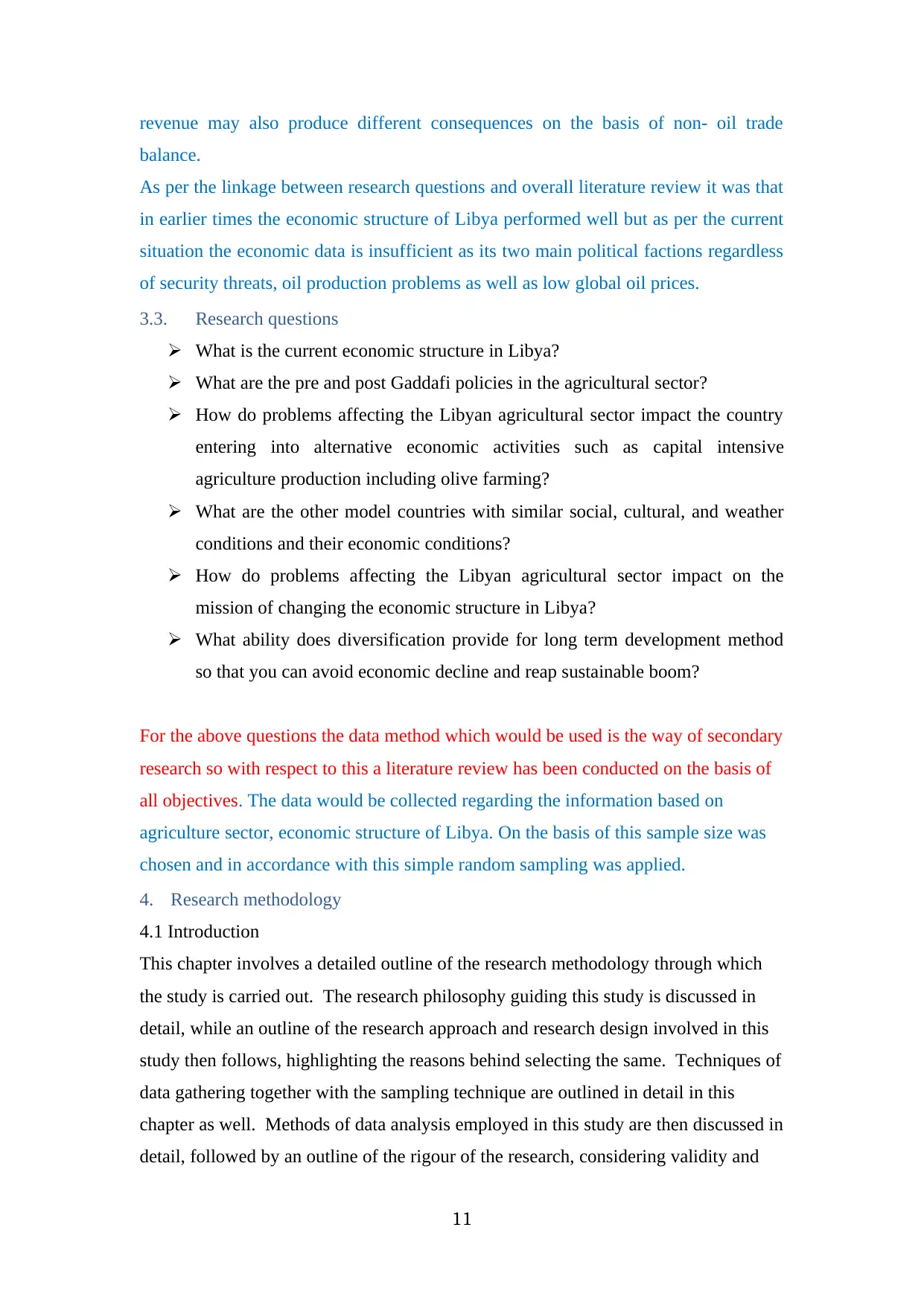
revenue may also produce different consequences on the basis of non- oil trade
balance.
As per the linkage between research questions and overall literature review it was that
in earlier times the economic structure of Libya performed well but as per the current
situation the economic data is insufficient as its two main political factions regardless
of security threats, oil production problems as well as low global oil prices.
3.3. Research questions
What is the current economic structure in Libya?
What are the pre and post Gaddafi policies in the agricultural sector?
How do problems affecting the Libyan agricultural sector impact the country
entering into alternative economic activities such as capital intensive
agriculture production including olive farming?
What are the other model countries with similar social, cultural, and weather
conditions and their economic conditions?
How do problems affecting the Libyan agricultural sector impact on the
mission of changing the economic structure in Libya?
What ability does diversification provide for long term development method
so that you can avoid economic decline and reap sustainable boom?
For the above questions the data method which would be used is the way of secondary
research so with respect to this a literature review has been conducted on the basis of
all objectives. The data would be collected regarding the information based on
agriculture sector, economic structure of Libya. On the basis of this sample size was
chosen and in accordance with this simple random sampling was applied.
4. Research methodology
4.1 Introduction
This chapter involves a detailed outline of the research methodology through which
the study is carried out. The research philosophy guiding this study is discussed in
detail, while an outline of the research approach and research design involved in this
study then follows, highlighting the reasons behind selecting the same. Techniques of
data gathering together with the sampling technique are outlined in detail in this
chapter as well. Methods of data analysis employed in this study are then discussed in
detail, followed by an outline of the rigour of the research, considering validity and
11
balance.
As per the linkage between research questions and overall literature review it was that
in earlier times the economic structure of Libya performed well but as per the current
situation the economic data is insufficient as its two main political factions regardless
of security threats, oil production problems as well as low global oil prices.
3.3. Research questions
What is the current economic structure in Libya?
What are the pre and post Gaddafi policies in the agricultural sector?
How do problems affecting the Libyan agricultural sector impact the country
entering into alternative economic activities such as capital intensive
agriculture production including olive farming?
What are the other model countries with similar social, cultural, and weather
conditions and their economic conditions?
How do problems affecting the Libyan agricultural sector impact on the
mission of changing the economic structure in Libya?
What ability does diversification provide for long term development method
so that you can avoid economic decline and reap sustainable boom?
For the above questions the data method which would be used is the way of secondary
research so with respect to this a literature review has been conducted on the basis of
all objectives. The data would be collected regarding the information based on
agriculture sector, economic structure of Libya. On the basis of this sample size was
chosen and in accordance with this simple random sampling was applied.
4. Research methodology
4.1 Introduction
This chapter involves a detailed outline of the research methodology through which
the study is carried out. The research philosophy guiding this study is discussed in
detail, while an outline of the research approach and research design involved in this
study then follows, highlighting the reasons behind selecting the same. Techniques of
data gathering together with the sampling technique are outlined in detail in this
chapter as well. Methods of data analysis employed in this study are then discussed in
detail, followed by an outline of the rigour of the research, considering validity and
11
⊘ This is a preview!⊘
Do you want full access?
Subscribe today to unlock all pages.

Trusted by 1+ million students worldwide
1 out of 42
Related Documents
Your All-in-One AI-Powered Toolkit for Academic Success.
+13062052269
info@desklib.com
Available 24*7 on WhatsApp / Email
![[object Object]](/_next/static/media/star-bottom.7253800d.svg)
Unlock your academic potential
Copyright © 2020–2025 A2Z Services. All Rights Reserved. Developed and managed by ZUCOL.





